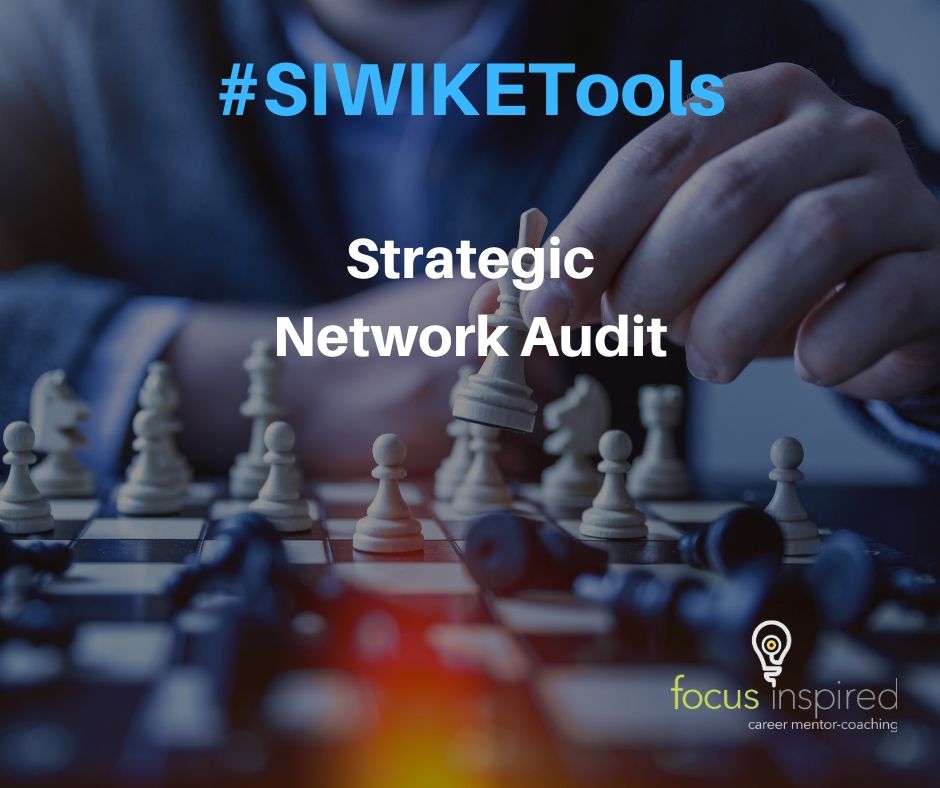
SIWIKE Tools: Strategic Network audit
Strategic Network audit
Who should I connect with and start building meaningful connections?
I often recommend folks to undergo a network audit if they ask me that question.
While a network audit takes an inventory of who you know, a strategic network audit takes a look at who you know AND compares that with who you feel you should know in the area that you want to get to in the future. The strategy comes with making a plan to connect with as many of them as possible in the coming weeks/months. It often doesn’t take very long and can be the start of something very important to help you navigate towards the goals and areas that you want to achieve.
A strategic network audit starts with where you want to go. Basically, what do you want? If you don’t know what that is then we have other exercises to help you with that.
The goal is to narrow down your want to a specific company and role. It could be anything from a business analyst at a bank, an accountant in a medium-size firm, and engineering in training at the technology firm. The principles remain the same, though the targets will differ.
Finding your key-person-of-interest
A strategic network audit starts by asking yourself who do you know that does that job?
If the answer is no one then this is where the fun starts. Go on Google, the company’s corporate site, LinkedIn, your alumni association website or whatever professional-finding platform and see if you can find someone with that job.
If you can’t find the name and contact information of a specific person, perhaps look at competitors to see if named people exist in those organizations. Or ask around to people in that industry or in that company and see if they know anybody.
That should be the first person on your BMC list.
If you’re unable to find a specific person, that’s OK for now. We can come back to it later and they are often found while searching for other people in the group/in the industry.
Potential colleagues
Then what you want to do is get a list of all the names of the people in the groups that that role might be part of. Check if there’s a business analytics group, and accounting group, and engineering group, or whatever group would be related to that area of interest for you. This could be people at any level: from senior executives to entry-level folks.
Those would be the next set of people on your BMC list.
Then take a look at the departments of competitors for that company. Also, look at anybody else in the company outside of that department. Ideally someone with some sort of common connection to you. Be it as an alumnus, a person in common, a cause I support (i.e. the environment, poverty, hunger, diversity, etc), or any potential area of commonality. Add them to your BMC list.
Tangential connections
Then look at other companies with downstream or upstream association with that company. These could be clients of the company. Or could be suppliers of the company. Or could be partners of the company. Or organizations that the company sponsors (perhaps a company sponsors a not for profit or other cause). Or is somehow otherwise affiliated with. Taking a look at the business news section could be helpful to find that sort of information. Or any communications that the company puts out on their website or other social media channels. Add them to your BMC list.
At this point, you should have a good set of people to connect with. You can start connecting virtually over LinkedIn. Engage in a conversation. Invite them out for a curiosity conversation where appropriate. You can volunteer at any of the connected organizations as there is a high likelihood that the sponsoring company would have representatives helping out as well (in this case make sure that you believe in the cause and are not doing it just for the networking or else that comes through in your interactions).
If you are lucky enough to get responses from everyone that you connect with then continue to build those connections. When you do connect with him make sure to be curious, interested and always look for opportunities to add value to them. After your curiosity conversation, if you feel it’s appropriate, ask them if they know anyone else that you should connect with. Over time, catch up if you can see an opportunity to help them, give them a quick proposal on how that might help them. At the end of the day, get into a mindset of caring for them and their career well-being. After all, if they are in an industry an area you want to get into, that will be of help to you in the long run.
If you aren’t so lucky and not many people respond back, think about a skill or experience or something that you could get that might make it more compelling for that person to want to connect with you. If you have sent a LinkedIn connection and they don’t reply to you after a couple of months, withdraw the connection and send an adjusted personalized note. Think about what’s in it for them? Why should they want to connect with you? What can you offer them? What value can you provide to them? That pursuit of looking to add more and more value will also be of benefit to you in the long run.
Happy BMC’ing! Do you have any great PMC experiences to share or need any help? Please email me at luki@focusinspired.com
Follow:Share: